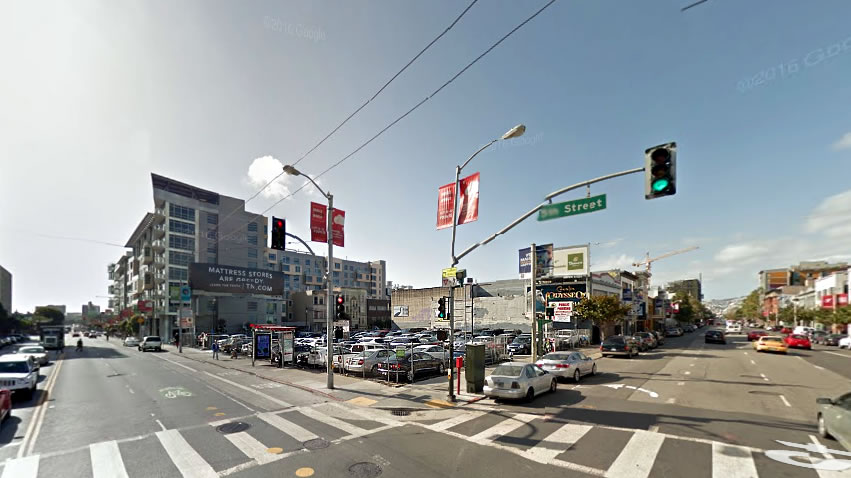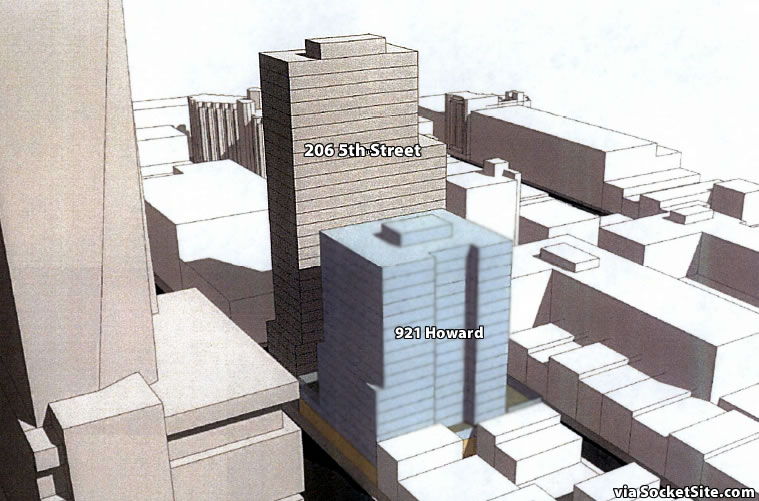As you might have noticed, there’s big mass lurking in the background of the plans for an 18-story tower with 205 below market rate apartments to rise at 921 Howard Street. And in fact, that other mass is a placeholder for a 30-story tower with over 200 residential units as well.
While currently only zoned for building up to 85 feet in height, the 206 5th Street parcel – which is currently known as the parking lot on the southwest corner of 5th and Howard pictured above – is slated to be up-zoned for development up to 300 feet per the City’s Central SoMa Plan.
And while the site is currently owned by the Tenderloin Neighborhood Development Corporation, having been acquired along with the adjacent two “921 Howard Street” parcels back in 2009, expect the plans for the 30-story tower, which have yet to be formally revealed, to be market rate condos with retail on the corner.


Since it’s the start of a new yea, it will be interesting to watch the rate of new large development proposals and compare it to previous years.
IIRC 2016 saw 79 or so – about 6 proposals/month. The lowest rate since 2012. Will 2017 see a fall-off from 2016?
I assume 921 Howard is not considered a new proposal, but that 206 5th would be – if everything falls in place with the Central SOMA up-zoning and the developer moves forward.
The Central SOMA plan, as is, is not a given – it will be contested. Many feel there is no need for additional height in the area, but the bigger issue with the plan is it worsens the jobs/housing imbalance and will exacerbate the housing crisis – not to mention further worsen street/highway congestion.
I’d be surprised if the plan, as now envisioned, will stand. Hopefully the Supervisors will aid in changing it but, if not, the broad opposition could lead to initiative(s) challenging the plan. .
Not sure all those things hold true. Salesforces is a good example. They are scattered around the Southbay as well as downtown so having them conslidate in one place should actually lessen traffic. Office space in SoMa, with abundant public transit options should lessen traffic to and from the SouthBay, especially if groups like Facebook start to consider the city more, like Google is doing as well.
Even assuming all the jobs will go to high paid techies who can afford to purchase a condo/home in SF, the numbers are way out of line. Almost 6 jobs for every new housing unit per the revised Central SOMA Plan – 7800 housing units and 45000 new workers.
It’s worse than that as many (most?) of these new workers won’t be able to afford to live in SF and will commute – most likely from the East Bay using the at capacity bridge and BART tube.
This is where the Supervisors, if not the PC itself, need to revise the revised Central SOMA plan For starters a housing/jobs balance approaching 1/1 maybe?
Many of those people already live in SF , and will now stop commuting to peninsula
that’s a nonsensical perspective. Why look at a single small neighborhood plan? What about a block? A building? Does every scale of geography have to have balance? By that measure, all the other plans the city has adopted are way out of whack with all housing and no jobs. In fact almost all of the plans the City has undertaken over the past couple decades are about housing and that’s about it. Market Octavia? Eastern Neighborhoods? Treasure Island? Parkmerced? Rincon Hill? Balboa Park? Van Ness? They are all housing and pretty much nothing else. You can’t zoon in on a micro geography of a city or even a region and expect a balance. Balance matters at a larger commute-level geography. We don’t expect everyone to walk to work. We do however expect and want people to take transit, so we need to make sure jobs are near transit. That means the closest in land near major regional transit hubs should be mostly jobs-oriented. Plenty of studies show that’s what matters most. The rest of the city is for housing.
The point is SF has not looked at the housing needs of the city as a whole – let alone a single district like Central SOMA.
SF under M allows 800K feet of new office space/year (big developments over 50K) and at 1 worker/200 square feet that amounts to 4000 workers/year. SF has not, until recently, built more than 3000 units per year. Add in the M exemption for HP Lennar and it will be close to 1,2000,000 per year for a decade or so. Requiring 6000 units/year.
A housing imbalance exists in the HP Lennar project, Pier 70, 3M and other big planned developments. But it is not nearly as bad as the almost 6/1 imbalance of the proposed Central SOMA plan.
Until a citywide solution is adopted then it will need to be piecemeal. Starting hopefully with the eventual Central SOMA plan. Instead of 7K units of housing and 45K jobs, how about 20K units of housing and 20K jobs?
TI and Parkmerced do not have office components, but Salesforce does not have a residential component.
Central SOMA will be contentious because of this and other issues. The plan as is, IMO, is unacceptable.
I’m in total agreement with Dave on the jobs-housing balance of Central SoMa (and Pier 70) being a problem. There aren’t enough big residential-only projects or area plans elsewhere in the city to cancel out Central SoMa’s bias toward office space.
I don’t mind the proposed increased building heights and would even prefer we go higher (Dave might not agree with that part), but what’s inside the buildings should be balanced more toward homes and less toward offices.
So are you supportive of 206 5th Street, which is an residential development?
+200 BMR apartments. That’s +200 singles/couples/families finally able to secure their own home.
No. If these were priced at market rate, +200 singles/couples/families would still finally have been able to secure their own home. What the city has done is simply favor a different set of 200 households, based on the twisted requirement that they make slightly less money than those other 200 households. Seems like a good way for clever politicians to get votes from people who dream of getting some free stuff on the collective dime, but removing incentives from an economy never works out well.